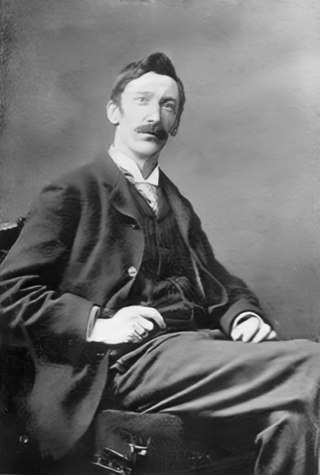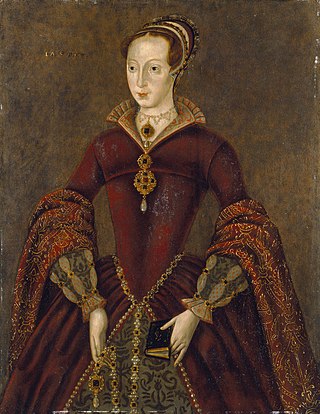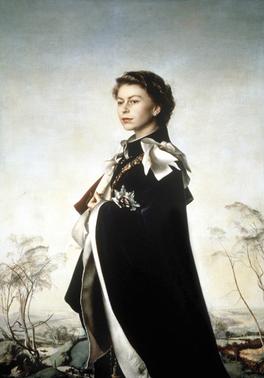
A conversation piece refers to a group portrait in a domestic or landscape setting depicting persons chatting or otherwise socializing with each other. The persons depicted may be members of a family as well as friends, members of a society or hunt, or some other grouping who are shown sharing common activities such as hunts, meals, or musical parties. It was an especially popular genre in 18th-century England, beginning from the 1720s, largely due to the influence of William Hogarth. Similar paintings can also be found in other periods and outside of England. The setting of various figures "conversing" in an intimate setting appears to call for small-scale paintings, but some artists treated this subject manner in the Grand Manner, with almost life-size figures.

Lucian Michael Freud was a British painter and draughtsman, specialising in figurative art, and is known as one of the foremost 20th-century English portraitists. He was born in Berlin, the son of Jewish architect Ernst L. Freud and the grandson of Sigmund Freud. Freud got his first name "Lucian" from his mother in memory of the ancient writer Lucian of Samosata. His family moved to England in 1933, when he was 10 years old, to escape the rise of Nazism. He became a British naturalized citizen in 1939. From 1942 to 1943 he attended Goldsmiths' College, London. He served at sea with the British Merchant Navy during the Second World War.

Princess Marie Louise of Schleswig-Holstein was a granddaughter of Queen Victoria.

Princess Helena Victoria of Schleswig-Holstein was a granddaughter of Queen Victoria of the United Kingdom. From 1917 her name was simply Princess Helena Victoria.
Lady Sarah Frances Elizabeth Chatto is a member of the British royal family. She is the only daughter of Princess Margaret, Countess of Snowdon, and Antony Armstrong-Jones, 1st Earl of Snowdon. She and her brother, David Armstrong-Jones, 2nd Earl of Snowdon, are the only maternal first cousins of King Charles III. She is the youngest grandchild of King George VI and Queen Elizabeth The Queen Mother. At her birth, she was 7th in line to the British throne; as of May 2023, she is 28th. Though she does not undertake public duties, she frequently attends events and ceremonies with the wider royal family.

Sir Francis Grant was a Scottish portrait painter who painted Queen Victoria and many distinguished British aristocratic and political figures. He served as President of the Royal Academy.

Stanhope Alexander Forbes was a British artist and a founding member of the influential Newlyn school of painters. He was often called 'the father of the Newlyn School'.

Royal Lodge is a Grade II listed house in Windsor Great Park in Berkshire, England, half a mile north of Cumberland Lodge and 3.2 miles (5.1 km) south of Windsor Castle. The site of homes since the 17th century, the present structure dates from the 19th century, and was expanded in the 1930s for the then duke of York, the future king George VI. Its central section is 3 storeys, with wings two storeys and it has about 30 rooms, with 7 bedrooms. The Royal Chapel of All Saints was built on the grounds in the 1820s.

Pietro Annigoni, OMRI was an Italian artist, portrait painter, fresco painter and medallist, best known for his painted portraits of Queen Elizabeth II. His work was in the Renaissance tradition, contrasting with the modernist style that prevailed in his time.

Robert Peake the Elder was an English painter active in the later part of Elizabeth I's reign and for most of the reign of James I. In 1604, he was appointed picture maker to the heir to the throne, Prince Henry; and in 1607, serjeant-painter to King James I – a post he shared with John De Critz.

Alexis Simon Belle was a French portrait painter, known for his portraits of the French and Jacobite nobility. As a portrait artist, Belle's style followed that of his master François de Troy, Hyacinthe Rigaud, and Nicolas de Largillière. He was the master of the painter Jacques-André-Joseph-Camelot Aved (1702–1766).
Sir Herbert James Gunn RA RP was a Scottish landscape and portrait painter.

The "Streatham" portrait is an oil painting on panel from the 1590s believed to be a later copy of a woodcut of the English noblewoman Lady Jane Grey from 1580. It shows a three-quarter-length depiction of a young woman in Tudor-period dress holding a prayer book, with the faded inscription "Lady Jayne" or "Lady Iayne" in the upper-left corner. It is in poor condition and damaged, as if it has been attacked. As of January 2015 the portrait is in Room 3 of the National Portrait Gallery in London.

The Graham Children is an oil painting completed by William Hogarth in 1742. It is a group portrait depicting the four children of Daniel Graham, apothecary to King George II. The youngest child had died by the time the painting was completed.

Preparing for a Fancy Dress Ball, also known as The Misses Williams-Wynn, is a 173 by 150 cm oil on canvas by English artist William Etty, first exhibited in 1835 and currently in the York Art Gallery. Although Etty was then known almost exclusively for history paintings featuring nude figures, he was commissioned in 1833 by Welsh Conservative politician Charles Watkin Williams-Wynn to paint a portrait of two of his daughters. Preparing for a Fancy Dress Ball shows Williams-Wynn's daughters, Charlotte and Mary, in lavish Italian-style costume: Charlotte, the eldest, is shown standing, helping the seated Mary decorate her hair with a ribbon and a rose. Etty put a good deal of effort into the piece and took much longer than usual to finish it.

Pietro Annigoni completed a number of portraits of Queen Elizabeth II between 1954 and 1972. In 1955, he painted her for the Worshipful Company of Fishmongers and in 1969 for the National Portrait Gallery. The two portraits were united for the National Portrait Gallery's exhibition; The Queen: Art and Image, held to mark the Diamond Jubilee of Queen Elizabeth II in 2012. In 1972, Annigoni completed a circular drawing of the Queen and Prince Philip, Duke of Edinburgh to mark their silver wedding anniversary.
Geoffrey Alan Rock was an English/Canadian painter. He was best known for his proficiency in realism. Rock’s work can be found in art collections around the world.

Queen Elizabeth II is a 2016 painting of the British monarch by British-Canadian artist Henry Ward. Its full title is Her Majesty Queen Elizabeth II with the Founder of the British Red Cross Henri Dunant. Painted in secret in Canada, it was unveiled by the Queen at Windsor Castle that October and commemorated the Queen's 60-year role as the patron of the British Red Cross.
Howard James Morgan was a British portrait painter who painted three queens. His work is held in the collection of the National Portrait Gallery, London.
Sir Hugh Frank John Leggatt was a British art dealer and patron. He was the senior partner in the gallery Leggatt Brothers, and art dealer to members of the Royal Family, including Queen Mary, and Queen Elizabeth, The Queen Mother. Leggatt financed the National Portrait Gallery's commission of the first official portrait of The Princess of Wales.















